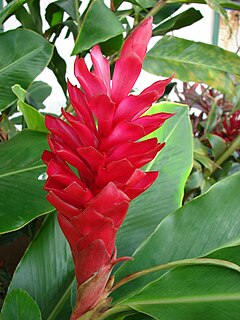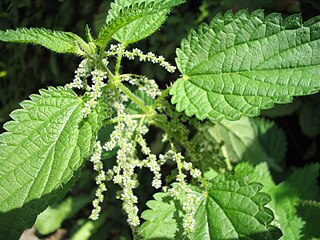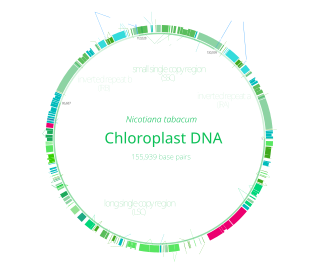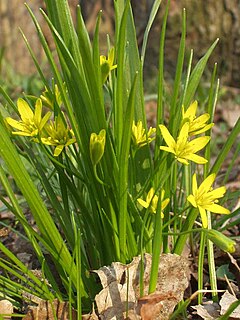Related Research Articles

Asparagales is an order of plants in modern classification systems such as the Angiosperm Phylogeny Group (APG) and the Angiosperm Phylogeny Web. The order takes its name from the type family Asparagaceae and is placed in the monocots amongst the lilioid monocots. The order has only recently been recognized in classification systems. It was first put forward by Huber in 1977 and later taken up in the Dahlgren system of 1985 and then the APG in 1998, 2003 and 2009. Before this, many of its families were assigned to the old order Liliales, a very large order containing almost all monocots with colorful tepals and lacking starch in their endosperm. DNA sequence analysis indicated that many of the taxa previously included in Liliales should actually be redistributed over three orders, Liliales, Asparagales, and Dioscoreales. The boundaries of the Asparagales and of its families have undergone a series of changes in recent years; future research may lead to further changes and ultimately greater stability. In the APG circumscription, Asparagales is the largest order of monocots with 14 families, 1,122 genera, and about 36,000 species.

The Zingiberales are flowering plants forming one of four orders in the commelinids clade of monocots, together with its sister order, Commelinales. The order includes 68 genera and 2,600 species. Zingiberales are a unique though morphologically diverse order that has been widely recognised as such over a long period of time. They are usually large herbaceous plants with rhizomatous root systems and lacking an aerial stem except when flowering. Flowers are usually large and showy, and the stamens are often modified (staminodes) to also form colourful petal-like structures that attract pollinators.

Monocotyledons, commonly referred to as monocots, are grass and grass-like flowering plants (angiosperms), the seeds of which typically contain only one embryonic leaf, or cotyledon. They constitute one of the major groups into which the flowering plants have traditionally been divided, the rest of the flowering plants having two cotyledons and therefore classified as dicotyledons, or dicots.

The Bromeliaceae is a family of monocot flowering plants of 75 genera and around 3590 known species native mainly to the tropical Americas, with a few species found in the American subtropics and one in tropical west Africa, Pitcairnia feliciana.
Urticales is an order of flowering plants. Before molecular phylogenetics became an important part of plant taxonomy, Urticales was recognized in many, perhaps even most, systems of plant classification, with some variations in circumscription. Among these is the Cronquist system (1981), which placed the order in the subclass Hamamelidae [sic], as comprising:

The Urticaceae are a family, the nettle family, of flowering plants. The family name comes from the genus Urtica. The Urticaceae include a number of well-known and useful plants, including nettles in the genus Urtica, ramie, māmaki, and ajlai.

Brodiaeoideae are a monocot subfamily of flowering plants in the family Asparagaceae, order Asparagales. They have been treated as a separate family, Themidaceae. They are native to Central America and western North America, from British Columbia to Guatemala. The name of the subfamily is based on the type genus Brodiaea.

Brocchinia is a genus of the botanical family Bromeliaceae, and is the sole genus of the subfamily Brocchinioideae, containing 20 species. The genus is named for Giovanni Battista Brocchi, Italian naturalist (1772–1826). Brocchinia species are native primarily to the ancient Guayana Shield in southern Venezuela and Guyana, with some species extending into Colombia and northern Brazil. Its species are generally restricted to areas of sand and sandstone of the Roraima Formation; a few occur on granite.

Thismiaceae is a family of flowering plants whose status is currently uncertain. The Angiosperm Phylogeny Group classifications merge Thismiaceae into Burmanniaceae, noting that some studies have suggested that Thismiaceae, Burmanniaceae and Taccaceae should be separate families, whereas others support their merger.
Sequencia is a monotypic genus of plants in the family Bromeliaceae. The sole species is Sequencia serrata, endemic to the Vaupés region of Colombia.

Chloroplasts have their own DNA, often abbreviated as cpDNA. It is also known as the plastome when referring to genomes of other plastids. Its existence was first proven in 1962. The first complete chloroplast genome sequences were published in 1986, Nicotiana tabacum (tobacco) by Sugiura and colleagues and Marchantia polymorpha (liverwort) by Ozeki et al. Since then, hundreds of chloroplast DNAs from various species have been sequenced, but they are mostly those of land plants and green algae—glaucophytes, red algae, and other algae groups are extremely underrepresented, potentially introducing some bias in views of "typical" chloroplast DNA structure and content.

Lilioid monocots is an informal name used for a grade of five monocot orders in which the majority of species have flowers with relatively large, coloured tepals. This characteristic is similar to that found in lilies ("lily-like"). Petaloid monocots refers to the flowers having tepals which all resemble petals (petaloid). The taxonomic terms Lilianae or Liliiflorae have also been applied to this assemblage at various times. From the early nineteenth century many of the species in this group of plants were put into a very broadly defined family, Liliaceae sensu lato or s.l.. These classification systems are still found in many books and other sources. Within the monocots the Liliaceae s.l. were distinguished from the Glumaceae.
Alan W. Meerow is an American botanist, born in New York City in 1952. He specializes in the taxonomy of the family Amaryllidaceae and the horticulture of palms and tropical ornamental plants. He also works on the population genetics and molecular systematics of cycads and palms.

The Lilioideae are a subfamily of monocotyledonous perennial, herbaceous mainly bulbous flowering plants in the lily family, Liliaceae. They are found predominantly in the temperate and colder regions of the Northern Hemisphere, particularly East Asia and North America. The subfamily includes two tribes. They are of economic importance, particularly the lilies and tulips.

The Lilieae are a monophyletic tribe of monocotyledon perennial, herbaceous mainly bulbous flowering plants in the lily family (Liliaceae).

The taxonomy of Liliaceae has had a complex history since the first description of this flowering plant family in the mid-eighteenth century. Originally, the Liliaceae or Lily family were defined as having a "calix" (perianth) of six equal-coloured parts, six stamens, a single style, and a superior, three-chambered (trilocular) ovary turning into a capsule fruit at maturity. The taxonomic circumscription of the family Liliaceae progressively expanded until it became the largest plant family and also extremely diverse, being somewhat arbitrarily defined as all species of plants with six tepals and a superior ovary. It eventually came to encompass about 300 genera and 4,500 species, and was thus a "catch-all" and hence paraphyletic taxon. Only since the more modern taxonomic systems developed by the Angiosperm Phylogeny Group (APG) and based on phylogenetic principles, has it been possible to identify the many separate taxonomic groupings within the original family and redistribute them, leaving a relatively small core as the modern family Liliaceae, with fifteen genera and 600 species.

Narcisseae is a small tribe of plants belonging to the subfamily Amaryllidoideae of the Amaryllis family (Amaryllidaceae), where it forms part of the Eurasian clade, and is one of three tribes in the European (Mediterranean) clade. It contains two genera and approximately 58 species, but probably also Lapiedra. The two genera are distinguished from each other by the presence of a paraperigonium in the former.
Nina Rønsted is a Danish botanist, who is Director of Science and Conservation at The National Tropical Botanical Garden, Hawaii.
Barbara Ann Whitlock is a botanist, who earned a PhD from Harvard University, with a dissertation entitled Systematics and evolution of chocolate and its relatives c. 2000, an interest which continues.
Paul Edward Berry is an American botanist and curator. He is Director of the Wisconsin State Herbarium.
References
- ↑ Neyland, Ray; Lowell E. Urbatsch (1996). "The ndhF chloroplast gene detected in all vascular plant divisions". Planta. 200 (2): 273–277 P. doi:10.1007/bf00208318. PMID 8904810.
- ↑ Dong, Wenpan; Jing Liu; Jing Yu; Ling Wang; Shiliang Zhou (2012). "Highly Variable Chloroplast Markers for Evaluating Plant Phylogeny at Low Taxonomic Levels and for DNA Barcoding". PLoS ONE. 7 (4): e35071. Bibcode:2012PLoSO...735071D. doi:10.1371/journal.pone.0035071. PMC 3325284 . PMID 22511980.
- ↑ Patterson, T. B.; T. J. Givnish (2002). "Phylogeny, concerted convergence, and phylogenetic niche conservatism in the core Liliales: insights from rbcL and ndhF sequence data" (PDF). Evolution. 56 (2): 233–252. doi: 10.1111/j.0014-3820.2002.tb01334.x . PMID 11926492. Archived from the original (PDF) on April 21, 2004. Retrieved 14 January 2014.CS1 maint: discouraged parameter (link)
- ↑ Givnish, T.J.; Pires, J.C.; Graham, S.W.; McPherson, M.A.; Prince, L.M.; Patterson, T.B.; Rai, H.S.; Roalson, E.R.; Evans, T.M.; Hahn, W.J; Millam, K.C.; Meerow, A.W.; Molvray, M.; Kores, P.; O’Brien, H.E.; Kress, W.J.; Hall, J.; Sytsma, K.J. "Phylogeny of the monocotyledons based on the highly informative plastid gene ndhF: evidence for widespread concerted convergence" (PDF): 28–51. Archived from the original (PDF) on 16 January 2014. Retrieved 4 January 2014.Cite journal requires
|journal=(help)CS1 maint: discouraged parameter (link) In Columbus et al. (2006) - ↑ Givnish, T.J.; Pires, J.C.; Graham, S.W.; McPherson, M.A.; Prince, L.M.; Patterson, T.B.; Rai, H.S.; Roalson, E.R.; Evans, T.M.; Hahn, W.J; Millam, K.C.; Meerow, A.W.; Molvray, M.; Kores, P.; O’Brien, H.E.; Kress, W.J.; Hall, J.; Sytsma, K.J. (2005). "Repeated evolution of net venation and fleshy fruits among monocots in shaded habitats confirms a priori predictions: evidence from an ndhF phylogeny". Proceedings of the Royal Society B: Biological Sciences. 272 (1571): 1481–1490. doi:10.1098/rspb.2005.3067. PMC 1559828 . PMID 16011923.
